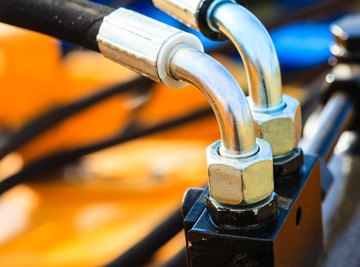
Hydraulic systems use pressurized liquid to transmit and magnify forces. A simple model of a hydraulic actuator can be constructed with easily available materials and used to demonstrate the principles of such systems. You may have seen hydraulic actuators on construction equipment or other heavy machinery in the form of large "rams" – cylinders that extend and contract to manipulate the shovels or blades of the machine. This model may be used in support of a science fair or class project along with a poster or paper explaining how it operates, or simply as a fun activity to stimulate understanding of a common technology.
1. Prepare Your Materials
Get a 20 ml syringe, a 100 ml syringe, some rubber tubing and vegetable oil. The syringes can be purchased at most pharmacies, while the rubber tubing is available at aquarium shops. Remove the needles from the syringes. The needles will not be needed for the construction of the model.
2. Fill the Syringes
Fill the syringes half full with vegetable oil. Do this by dipping the nozzle of the syringe into a bowl of vegetable oil and slowly pulling the plunger until the barrel of the syringe is approximately half full. Make sure that there are no bubbles in the barrel of the syringe, as this can affect the operation of the model. If bubbles form when you are filling the syringes, push the oil out of the syringe and redo the filling process.
Wipe away any excess oil with a paper towel and push the plungers down just far enough so that there is no air in the nozzle of the syringes.
3. Attach the Tubing
Insert the nozzle of the larger syringe into one end of the rubber tubing. If you have difficulty getting the end of the tubing to fit over the syringe nozzles, submerge the ends of the tubing in hot water for a few minutes. This will expand the rubber tubing and also make it softer and more malleable.
Push down on the large syringe's plunger until oil nearly reaches the end of the tubing, leaving just a centimeter or so of tubing empty so that you have something to hold on to. Don't push down on the plungers when inserting the nozzles of the syringes into the tubing or oil may be pushed out of the syringes, creating quite a mess.
Now attach the free end of the tubing to the nozzle of the smaller syringe in the same way.
4. Test Your Simple Hydraulic System
Operate the completed model by pushing down on one or the other plunger. The other plunger will rise. When you push down the plunger of the smaller syringe, the plunger of the larger one will rise a smaller distance but with greater force. Because its barrel has a larger diameter and therefore a larger volume, the (incompressible) fluid moves its plunger through a smaller distance. But because it moves over a smaller distance it generates a larger force. This is a "mechanical advantage," similar to how pulling the rope of a pulley with small force for a large distance can lift a large weight a small distance.
Things You'll Need
- 20 ml syringe
- 100 ml syringe
- Rubber or plastic tubing (10-15 cm)
- Vegetable oil
Warnings
Be careful not to prick yourself with the discarded needles; they are extremely sharp.
References
Tips
- The syringes can be purchased at most pharmacies, while the rubber tubing is available at aquarium shops.
- If bubbles form when you are filling the syringes, push the oil out of the syringe and redo the filling process.
- If you have difficulty getting the end of the tubing to fit over the syringe nozzles, submerge the ends of the tubing in hot water for a few minutes. This will expand the rubber tubing and also make it softer and more malleable.
- Don't push down on the plungers when inserting the nozzles of the syringes into the tubing or oil may be pushed out of the syringes, creating quite a mess.
Warnings
- Be careful not to prick yourself with the discarded needles; they are extremely sharp.
About the Author
Paul Bragulla began writing professionally in 2010, producing online articles. His experience as a researcher in beamed energy propulsion means that he can write knowledgeably about topics such as optics, laser operation and high-speed photography. Bragulla holds a Bachelor of Science in physics from Rensselaer Polytechnic Institute.
